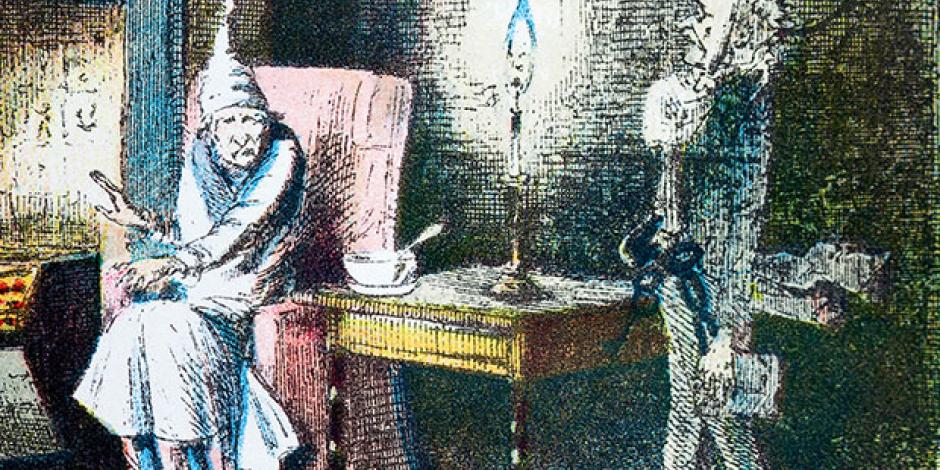Few Christmas stories are told and retold as often as A Christmas Carol. The novella by Charles Dickens (1812-70) was published 175 years ago, on 19 December 1843. Since then, the story of Scrooge, an uncaring boss who learns to be kind and generous, has been made into countless theatre and film versions. Just as important as the moral message of the story, however, is the way it popularized the idea of the modem English Christmas.
Like, some of Dickens’s other works, such as The Adventures of Oliver Twist (1837-39) and the autobiographical The Life and Adventures of Nicholas Nickleby (1838-39), A Christmas Carol gives us a view of life during the early Industrial Revolution. While an emergingim Entstehen begriffenemerging middle class enjoyed some conveniences, the working class suffered through filthDreckfilth, miseryElendmisery, over-crowding and stenchGestankstench. Dickens describes deep snow, chimney sootRuß aus den Schornsteinenchimney soot in the air, and nights of thick fog — actually smog. Large families were the norm, and many children didn’t have warm clothes to wear or enough food to eat.
What’s Christmas time to you but a time for paying bills without money; a time for finding yourself a year older, but not an hour richer?
We meet Ebenezer Scrooge, the owner of a small London bank, and Bob Cratchit, his only employee. It is the day before Christmas. Scrooge’s nephewNeffenephew invites his uncle to dinner, but Scrooge sees no reason to celebrate. “What’s Christmas time to you but a time for paying billRechnungbills without money; a time for finding yourself a year older, but not an hour richer?” Scrooge asks.
Then two men come in, collecting money for the poor. Scrooge tells them that his taxes should have been enough. Prisons and workhouse (UK)Armenhausworkhouses should to accommodate sb.jmdn. aufnehmen/ unterbringenaccommodate those whom society cannot, he says: “I don’t to make merryfeiernmake merry myself at Christmas, and I can’t afford to make idleuntätig, ohne Beschäftigungidle people merry.”
Scrooge’s business partner, Jacob Marley, died on that same day several years earlier. While walking through the dark to his private apartments — which Marley used to own — Scrooge begins to hallucinate. First, the door knocker turns into Marley’s face. Then Marley himself appears as a ghost in Scrooge’s bedroom.
Marley explains that those who don’t wander the earth during life, doing good things, are forced to wander the earth after death. He frightens Scrooge by showing him all the ghosts wandering around outside, invisibleunsichtbarinvisible to everyone else. Marley tells Scrooge that three more ghosts will visit him with words of warning.
The first to come is the Ghost of Christmas Past, a childlike figure with a light on its head. The ghost takes Scrooge back to his childhood, when he was left on his own to read a book, while all the other children were celebrating Christmas. The ghost then accompanies Scrooge to the time when, as a young man, his fiancéeVerlobtefiancée left him because he was too obsessed with his work.
The Ghost of Christmas Present looks a bit like Santa Claus. He takes Scrooge on a long tour to convince him that everyone everywhere celebrates Christmas. We see Bob Cratchit enjoying Christmas dinner with his wife and their several children, the youngest of whom is named tinywinzig, kleinTiny Tim, and we visit the party at the house of Scrooge’s nephew, which Scrooge himself starts to enjoy. The Ghost of Christmas Yet to Come is a frightening, hoodedmit Kapuzehooded figure who to resemble sb.jmdm. ähnelnresembles Death. Without speaking, he takes Scrooge into the near future. People are talking about the death of a rich man whose possessions they’ve taken. Scrooge doesn’t realize they are talking about him — until he sees his own graveGrabgrave.
Out of fear and regret, Scrooge to change one’s wayssein Verhalten ändernchanges his ways. On Christmas morning, he buys a turkey “twice the size of Tiny Tim” and sends it, anonymously, to the Cratchits. He goes to church and then to his nephew’s house for dinner. The following day, Bob Cratchit comes to work late, but Scrooge, instead of getting angry, decides to pay him more.
The story, as Dickens wrote it, is not about the evils of capitalism, nor is Scrooge shown to be in love with money. Instead, he believes in the value of working hard and earning money. Money is a kind of insuranceAbsicherunginsurance against the hard conditions that he sees others to face sth.einer Sache ins Auge sehenface. Scrooge in fact tries to save money whenever possible, even when lighting his home and heating his office.
A Christmas Carol was an immediate success when it came out
Without a family, Scrooge enjoyed peace and quiet on his own. (He spends Christmas Eve reading newspapers.) Scrooge might have been a JewJude, JüdinJew or an atheist, who had no interest in Christmas. (When wished a “merry Christmas”, he wishes a “good afternoon” in return.) A common and more likely interpretation, however, is that Scrooge was a Puritan. During the Middle Ages, and until just after Shakespeare’s time in the 1600s, Christmas in England was celebrated happily with decorations, song, food, games and alcohol. During the 17th century, the Puritans inspired a return to religion and a move towards austerityEntsagung, Strengeausterity. In the 19th century, the English were starting to rediscover the merry traditions of earlier times.
Santa Claus, invented in an American newspaper poem in 1822, slowly became popular in Britain as Father Christmas. Eighteen-year-old Queen Victoria to ascend sth.etw. besteigenascended the throne in 1837 and brought with her a spirit of youth and fun. Her German husband, Prince Albert, popularized the Christmas tree in Britain. The Victorian age brought light and colour to the holiday, and Dickens showed just how pleasant it could be.
Christian metaphors appear in the story — the Ghost of Christmas Past carries the light of salvationErlösungsalvation; Scrooge dies and is reborn in an act of redemptionErlösung; hier: Wiedergutmachungredemption — but religion is hardly mentioned. It is the ambienceAtmosphäre, Stimmungambience of Christmas, the spirit of goodwillWohlwollengoodwill and conformity that are important.
Typically for Dickens, he is able to make his characters very distincteindeutig, klar erkennbardistinct without using a lot of description. The author often uses comical understatement, and the dialogue gets right to the point — such as every time that Scrooge says “Bah! Humbug!” in reference to holiday cheer.
A Christmas Carol was an immediate success when it came out, selling all 6,000 copyExemplarcopies of its first print runAuflageprint run. Dickens travelled around, giving readings of the story, before it was to adapt sth. for sth.etw. für etw. bearbeitenadapted for the stage.
More for the Christmas season
Listen to a Christmas story or learn the vocabulary to talk about nativity plays or pantos:



